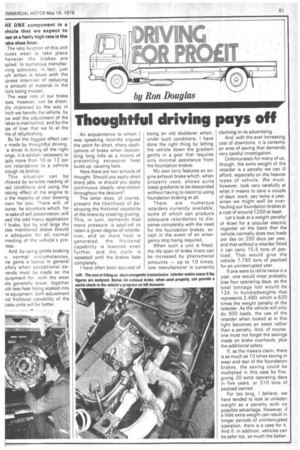Thoughtful driving pays off
Page 63

If you've noticed an error in this article please click here to report it so we can fix it.
HE ONE component in a .t,hicle that we expect to ear at a fairly high rate is the 'ake shoe liner.
The very function of this unit iuses wear to take place henever the brakes are )plied. In numerous manufaciring activities, in fact, just ich action is taken with the (press intention of reducing le amount of material in the ticle being treated.
The wear rate of our brake toes, however, can be drastiilly improved by the way in hich we handle the vehicle, by 71N well the adjustment of the rakes is maintained, and by the Tie of liner that we fit at the me of refurbishing.
By far the biggest effect can a made by thoughtful driving. a driver is doing all the right iings, it is seldom necessary to aply more than 10 or 12 per ant retardation to a vehicle trough its brakes.
This situation can be ohieved by sensible reading of )ad conditions and using the raking effect of the engine to o the majority of your slowing own for you. There will, of purse, be situations which, for le sake of self preservation, will eed the odd heavy application f brake, but by and large the ites mentioned above should e adequate for all normal rresting of the vehicle's proress.
And, by using gentle braking n normal circumstances, ne gains a bonus in general
afety when exceptional de-lands must be made on the quipment for. with the wear ate generally lower, together iith less heat being soaked into le equipment. both adjustment nd frictional capability of the irake units will be better.
An acquaintance to whom was speaking recently argued the point for short, sharp applications of brake when descending long hills as a means of preventing excessive heat build-up, causing fade.
Here there are two schools of thought. Should you apply short sharp jabs, or should you apply continuous steady retardation throughout the descent?
The latter does, of course, present the likelihood of destroying the frictional capability of the liners by creating glazing. This, in turn, demands that more pressure is applied to retain a given degree of retardation, and so more heat is generated, the frictional capability is lowered even further, and the cycle is repeated until the brakes fade completely.
I have often been accused of being an old dodderer when, under such conditions, I have done the right thing by letting the vehicle down the gradient .gently in a gear that requires only minimal assistance from the foundation brakes.
My own lorry features an engine exhaust brake which, when properly used, allows quite steep gradients to be descended without having to resort to using foundation braking at all.
There are numerous retarders currently available, some of which can produce adequate retardation to dispense completely with the need for the foundation brakes, except in the event of an emergency stop being required.
When such a unit is fitted, the life span of brake liners can be increased by phenomenal amounts — up to 10 times, one manufacturer is currently claiming in its advertising.
And, with the ever increasing cost of downtime, it is certainly an area of saving that demands very careful investigation.
Unfortunately for many of us, though, the extra weight of the retarder is a penalty we can ill afford, especially on the heavier types of vehicle. We must, however, look very carefully at what it means to save a couple of days' work, say twice a year, when we might well be overhauling our foundation brakes at a cost of around £250 at least.
Let's look at a weight penalty' of 4cwt for a popular electric regarder on the basis that the vehicle normally does two loads per day on 250 days per year, and that without a retarder fitted it can carry 15.5 tons of payload. That would give the vehicle 7,750 tons of payload for an uninterrupted year.
If one were to reline twice in a year, one would most probably lose four operating days, so the total tonnage lost would be 124. In hundredweights that represents 2,480, which is 620 times the weight penalty of the retarder. As the vehicle will only do 500 loads, the use of the retarder when looked at in this light becomes an asset rather than a penalty. And, of course, one must not forget the savings made on brake overhauls, plus the additional safety.
If, as the makers claim, there is as much as 10 times saving in wear and tear of the foundation brakes, the saving could be multiplied in this case by five, giving 20 extra operating days in five years, or 310 tons of payload carried.
For too long. I believe, we have tended to look at unladen weight as a penalty with no possible advantage. However, if a little extra weight can result in longer periods of uninterrupted operation, there is a case for it.
And if, in addition, vehicles can be safer too, so much the better.












































































































